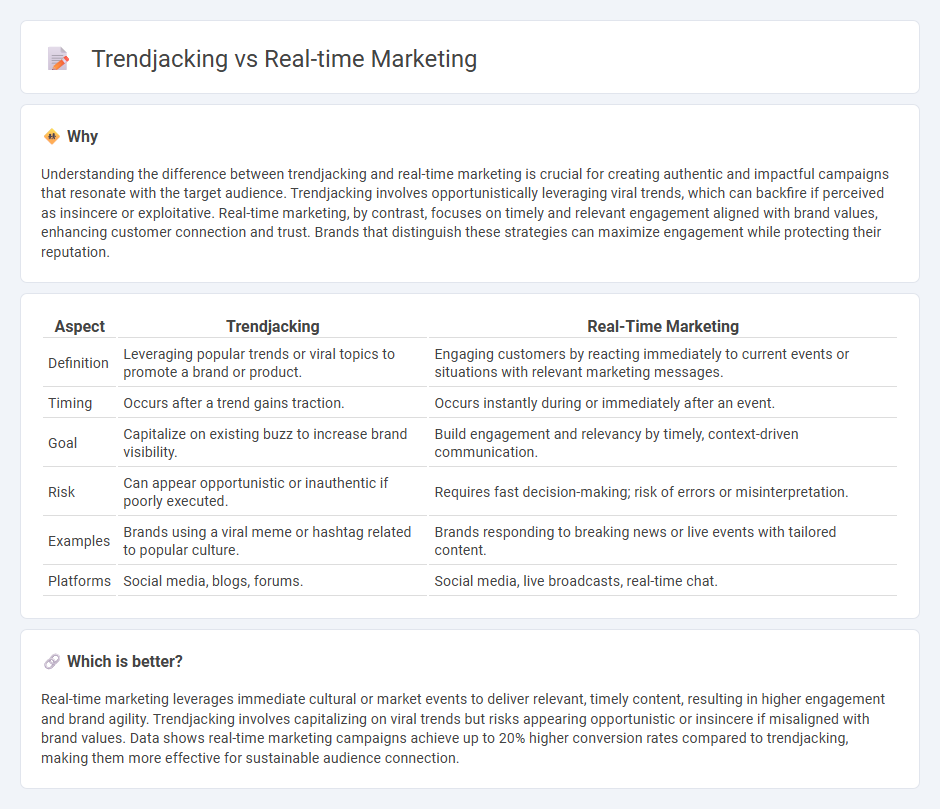
Trendjacking leverages popular cultural moments or viral trends to amplify brand visibility and engagement by inserting a brand's message into ongoing conversations, maximizing immediacy and relevance. Real-time marketing focuses on responding promptly to events or customer interactions as they happen, aiming to create timely, personalized experiences that enhance consumer connection and brand loyalty. Explore more about how trendjacking and real-time marketing strategies can transform your brand's impact in dynamic market environments.
Why it is important
Understanding the difference between trendjacking and real-time marketing is crucial for creating authentic and impactful campaigns that resonate with the target audience. Trendjacking involves opportunistically leveraging viral trends, which can backfire if perceived as insincere or exploitative. Real-time marketing, by contrast, focuses on timely and relevant engagement aligned with brand values, enhancing customer connection and trust. Brands that distinguish these strategies can maximize engagement while protecting their reputation.
Comparison Table
| Aspect | Trendjacking | Real-Time Marketing |
|---|---|---|
| Definition | Leveraging popular trends or viral topics to promote a brand or product. | Engaging customers by reacting immediately to current events or situations with relevant marketing messages. |
| Timing | Occurs after a trend gains traction. | Occurs instantly during or immediately after an event. |
| Goal | Capitalize on existing buzz to increase brand visibility. | Build engagement and relevancy by timely, context-driven communication. |
| Risk | Can appear opportunistic or inauthentic if poorly executed. | Requires fast decision-making; risk of errors or misinterpretation. |
| Examples | Brands using a viral meme or hashtag related to popular culture. | Brands responding to breaking news or live events with tailored content. |
| Platforms | Social media, blogs, forums. | Social media, live broadcasts, real-time chat. |
Which is better?
Real-time marketing leverages immediate cultural or market events to deliver relevant, timely content, resulting in higher engagement and brand agility. Trendjacking involves capitalizing on viral trends but risks appearing opportunistic or insincere if misaligned with brand values. Data shows real-time marketing campaigns achieve up to 20% higher conversion rates compared to trendjacking, making them more effective for sustainable audience connection.
Connection
Trendjacking leverages current viral topics or trends to amplify marketing messages, creating timely engagement with target audiences. Real-time marketing focuses on instantaneous content creation and response to ongoing events, ensuring brand relevance and increased visibility. Together, these strategies enable marketers to capitalize on trending conversations for enhanced consumer connection and brand awareness.
Key Terms
**Real-time marketing:**
Real-time marketing leverages current events and social media moments to create timely, relevant content that engages audiences instantly, boosting brand visibility and consumer interaction. This strategy depends on rapid response teams and data analytics to identify fleeting opportunities and craft appropriate messaging that aligns with the brand's voice. Explore deeper insights into real-time marketing techniques and their impact on customer engagement and ROI.
Timeliness
Real-time marketing capitalizes on immediate responses to current events, ensuring brand relevance by delivering timely content that resonates with audiences as situations unfold. Trendjacking involves leveraging viral trends or popular conversations to boost visibility, often by creatively inserting brand messages into ongoing cultural moments. Explore more insights on how timeliness impacts marketing strategies and effectiveness.
Contextual relevance
Real-time marketing capitalizes on current events and cultural moments with tailored messages designed for immediate audience engagement, ensuring high contextual relevance. Trendjacking involves brands leveraging viral trends or popular hashtags to insert themselves into conversations, aiming for quick visibility but risking misalignment if relevance is forced. Explore the nuances of contextual relevance in these strategies to optimize brand impact effectively.
Source and External Links
Real Time Marketing | Sprout Social - Real-time marketing is the process of engaging customers instantly based on breaking news or trending information, focusing on triggers, audience, method, and desired outcomes to deliver timely, targeted campaigns that boost engagement and brand relevance.
Real-time marketing - Wikipedia - Real-time marketing is marketing executed "on-the-fly" to provide the most appropriate approach to a customer at a specific time and place, emerging in the mid-1990s and often involving advanced decisioning software and predictive models for personalized interaction.
Real Time Marketing: Full-Service Digital Marketing Agency - Real Time Marketing is a full-service in-house digital marketing agency offering data-driven strategies and a broad suite of digital marketing services designed to help businesses grow and improve ROI.
 dowidth.com
dowidth.com